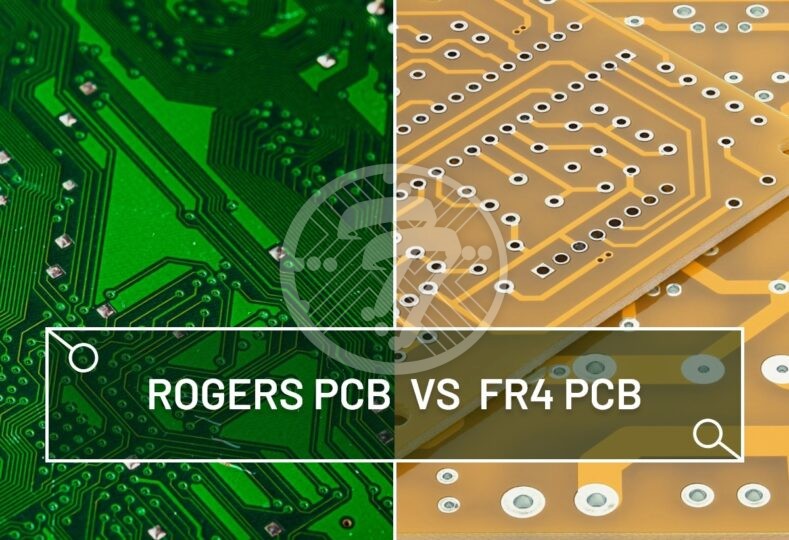Rogers PCB Vs FR4 PCB – What is the Difference?

Introduction
In the world of hi-tech gadgets, medical equipment, and Industrial Machines, the performance of any product depends mainly on the quality of its PCB design.
Though there are multiple aspects to be considered while designing a PCB, our focus here is to identify the right PCB material which is also known as Substrate. Substrates are the di-electric sheets that hold the components and traces of a design. Selecting the right substrate material for a specific application is the key aspect of PCB design. To decide which substrate works best for any given application, we need to know the salient features of all the materials available on the market. The materials offered include FR1 to FR6, CEM1 to CEM5, insulated metal substrates, Polytetrafluorethylene (PTFE), polyimide, etc. Among all these, FR4 is considered the most commonly used substrate by many PCB manufacturers.
What makes ‘FR4 PCBs’ a commonly used type?
FR4 PCBs (Printed Circuit Boards) are widely used, low-cost PCBs categorized as ‘Best Performers’ in most environmental conditions. As per the NEMA standard, FR4 signifies the Fire-Retardant characteristic of the composite material. They are made from woven fiberglass cloth reinforced with epoxy resin. FR4 material is the most cost-effective type available for circuit board fabrication. They are lightweight, moisture-resistant, and have high dielectric strength.FR4 PCBs are an appropriate choice for through-hole technology in component mounting. Thus, they are extensively used in most manufacturing techniques and provide high yield.
Then why Rogers PCBs are required?
Roger PCBs are manufactured by Rogers Corporation and are mainly used in high-frequency and high-speed designs. Their excellent dielectric constant and ability to sustain elevated temperatures make them the Best Quality PCBs for RF products and microwave devices. They are available in several types based on required board resistance and high dielectric constant. Roger PCBs are good in thermal management and hence maintain the consistency of the product. Also, they have low outgassing, a vital feature necessary in the space and aeronautics industry.
So, let’s understand the Differences between Rogers PCBs and FR4 PCBs:
Cost is the first and foremost difference to be considered in this section. The ultimate goal of any PCB manufacturer is to bring out a cost-effective circuit board with the best performance. FR4 PCBs are the most affordable ones in the market. This is valid if your design is for optimal conditions with low-frequency and nominal temperature settings. If your application demands high speed or extreme temperature operations, then you may have to overlook the cost and go for expensive Rogers PCBs.
Impedance Stability is the next difference between FR4 and Rogers PCBs. The dielectric constant of the substrate is one significant factor that defines the Board Impedance and its stability. The higher the dielectric constant, the higher is the Impedance stability. Though FR4 is the cheapest substate available, its maximum di-electric value is 4.5. Whereas Roger PCBs has a higher and wider range of di-electric value like 6.5 to 11. This feature makes Rogers PCBs the best choice in high-thermal applications where the stable impedance is crucial.
Thermal Management is in continuation with the previous difference we have discussed. In high-speed applications, there will be significant heat generation in the PCB, and it must be handled diligently with a good thermal management system. In such scenarios, a thermostat-based laminate present in Rogers PCB is the best choice. FR4 PCBs cannot handle high temperatures and thus fail in such applications.
Dissipation Factor indicates the signal loss in the PCB which is much lower in Rogers PCB as compared to FR4 PCBs. The dissipation factor of FR4 PCBs is 0.02% as compared to 0.004% in Rogers PCB. So, Rogers PCB provides reliable results with minimal electrical signal loss against FR4 PCBs.
Moisture Absorption is directly related to the electrical and thermal characteristics of the substrate material. This in turn affects the performance of the circuit board. Rogers PCB has the least moisture absorption and thus provides the best efficiency in varying environmental conditions.
Applications and Performances Based on the overall performance, FR4 PCBs are considered as Decent players whereas Rogers PCBs are remarkable performers. Hence FR4 PCBs are best fit in the optimal environment with low to mid-frequency applications. They are robust and deliver excellent balance in electrical stability and are easily manufacturable in almost all existing processes in the PCB industry. Whereas Roger PCBs are meant for high-grade performances in niche domains like space applications. The temperature constancy and low outgassing feature make them the best choice for critical applications like space and aerodynamics.
Let’s conclude
Diverse applications in the electronic industry come with a demand for varied types of PCB requirements. Based on the usage and performance, it is necessary to make the right choice of PCB material that can bring out the best product to your customer. So, is it FR4 PCB or Rogers PCB?
The end application is the best selection criteria.
At Technotronix, we combine state-of-the-art technology with our advanced engineering to offer you Rogers printed circuit boards & FR4 Printed Circuit Boards of the highest quality. With over four decades of experience in delivering high quality, on-time, price-competitive products, you can rely on us for your PCB requirements.
To get more insights into the PCB fabrication and PCB assembly services, please explore our PCB fabrication services. Also, you can drop an email to [email protected] or give us a call at 714/630-9200 to solve your queries or to get a quote.






